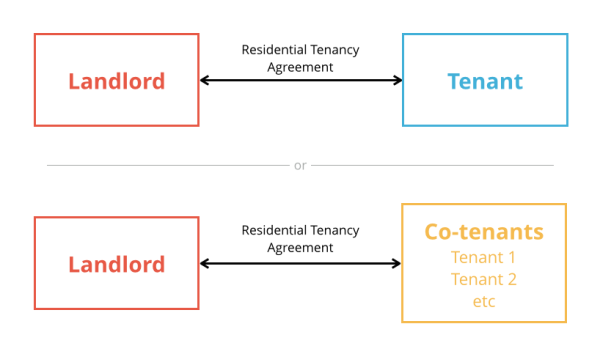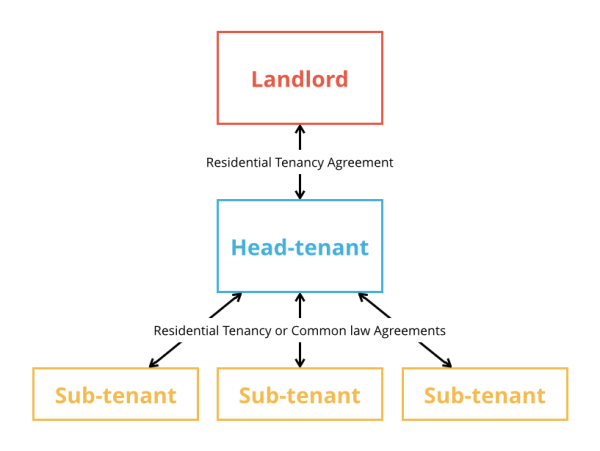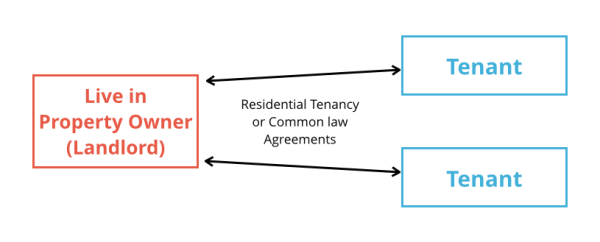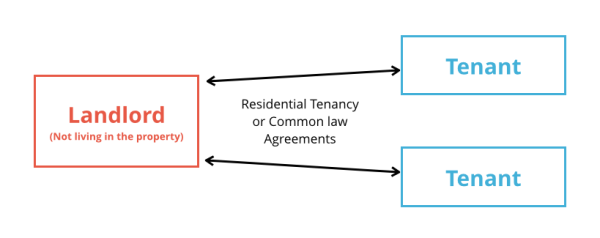What is my tenancy situation?
There are 3 different areas of law that cover share accommodation in Australia:
- State or Territory specific Residential Tenancy Acts
- State or Territory specific Rooming/Boarder/Lodger Acts
- Australian Common Law Boarding, Lodging, or Roomer agreements
Which category your tenancy fits in makes a significant difference to your rights and obligations as a landlord or a tenant.
Situation 1: Tenant(s) rent a whole property on a single Tenancy Agreement from a live out landlord

This is common in share accommodation situation where a group of co-tenants are listed on a single tenancy agreement. Legally it’s the same as a single tenant renting a whole property.
In this situation you should always use a standard form Residential Tenancy Agreement and the bond needs to be registered or held by the relevant authority in your state. Your rights and obligation are those provided in the residential tenancy act of your state or territory.
All co-tenants jointly share the same rights and obligations under the tenancy agreement. The division of rent is a matter of agreement between the co-tenants, but all co-tenants are jointly liable for the whole of the rental amount and any damages that occur to the property.
Situation 2: Head-tenant sublets rooms in rental property

In this situation the head-tenant fulfils 2 roles. They are the tenant with the main landlord (property owner) but they are also the landlord for the sub-tenants.
The agreement between the head-tenant and landlord will be covered by the residential tenancy act in your state or territory (unless the tenancy is for commercial purposes) meaning the rights and obligations will be covered by those acts, and the bond should be registered with the relevant government authorities.
The head-tenant also fulfils the role of landlord to the sub-tenants. These agreements may come under your state or territory residential tenancy act or the common law.
By not using a residential tenancy agreement, you may fall under the common law and not your state or territory residential tenancy act. It is in the best interests of both a head-tenant and a sub-tenant to use the standard form residential tenancy agreement. Using this agreement will apply all the rights, protections and processes under the residential tenancy act. This provides greater certainty and also means that all legal recourse is far more accessible.
If you do not use a residential tenancy agreement, you may come under a common law boarding or lodging agreement. In this situation, if an issue arises it will generally be much more difficult to enforce your rights in a tribunal or court. This would be both costly and time consuming, especially given the often small amounts of money at stake.
The best approach is to opt into your state or territory residential tenancy act by signing the standard form tenancy agreement.
There are two options for doing this:
- List the incoming tenants on the same residential tenancy agreement as the existing tenant. This means your situation changes to Situation 1 (above) and the existing tenant and incoming tenant(s) become co-tenants.
- The existing tenant becomes a head-tenant by signing a Residential Tenancy agreements with each of the incoming tenants who become sub-tenant(s).
Situation 3: Live in property owner rents out spare rooms

This situation could fall under the residential tenancy acts or the common law.
By not using a residential tenancy agreement, you may fall under the common law and not your state or territory residential tenancy act. It is in the best interests of both a property owner and a tenant to use the standard form residential tenancy agreement. Using this agreement will apply all the rights, protections and processes under the residential tenancy act. This provides greater certainty and also means that all legal recourse is far more accessible.
If you do not use a residential tenancy agreement, you may come under a common law boarding or lodging agreement. In this situation, if an issue arises it will generally be much more difficult to enforce your rights in a tribunal or court. This would be both costly and time consuming, especially given the often small amounts of money at stake.
Th best approach is to opt into your state or territory residential tenancy acts by using the standard form tenancy agreement.
The agreement should clearly state which part of the property the tenant has access and responsibility for and the rules for the shared parts of the property.
Situation 4: Live out landlord who rents out rooms on individual contract

This situation could fall under the residential tenancy acts or the common law.
By not using a residential tenancy agreement, you may fall under the common law and not your state or territory residential tenancy act. It is in the best interests of both a landlord and a tenant to use the standard form residential tenancy agreement. Using this agreement will apply all the rights, protections and processes under the residential tenancy act. This provides greater certainty and also means that all legal recourse is far more accessible.
If you do not use a residential tenancy agreement, you may come under a common law boarding or lodging agreement. In this situation, if an issue arises it will generally be much more difficult to enforce your rights in a tribunal or court. This would be both costly and time consuming, especially given the often small amounts of money at stake.
A better approach is to opt into your state or territory residential tenancy acts by using the standard form tenancy agreement.
The difference between this and Situation 1 (co-tenants) is that the tenants are on individual agreements so they are only liable under the terms of that agreement.
The agreement should clearly state which part of the property the tenant has access and responsibility for and the rules for the shared parts of the property.
Situation 5: Rooming, Boarding or Lodging Houses
If your agreement does not fall under your state or territory residential tenancy act as a residential tenancy agreement, then it will be a boarding, lodging, or rooming agreement. The difference between lodging and rooming on one hand, and boarding on the other hand, is that a lodging or rooming agreement is just for accommodation while a boarding agreement is for accommodation and services such as meals and cleaning.
Boarding, lodging and rooming fall into two categories which apply in most states and territories:
- Common law boarding, lodging or rooming agreements
- Legislative boarding, lodging or rooming agreements
Although there is variation between states and territories, for a boarding, lodging or rooming agreement to be a legislative agreement it will generally need to be for a boarding/lodging/rooming house with a minimum number of occupants, usually 3-4 people. If the boarding/lodging/rooming house does not meet this minimum amount, then the agreement will be a common law agreement.
While legislative boarding, lodging, or rooming agreements are subject to regulations designed to protect landlords and boarders/lodger/roomers, common law agreements, as mentioned previously, do not have any guaranteed rights or protections. The only rights and obligations are those agreed to by the landlord and the boarder, lodger, or roomer under common law agreements.
Either way, Flatmates.com.au strongly recommends opting into your state or territory residential tenancy act by using the standard form residential tenancy agreement. This will provide greater certainty and protections for landlords and tenants in all circumstances.
It is highly advisable if you are a landlord and you think your situation could be effected by the Rooming/Boarder/Lodger acts that you seek legal advice. The penalties for non compliance and access to the property by council inspectors is very different that that of the Residential Tenancy acts. Boarding, lodging or rooming houses which have a certain minimum number of people are regulated by legislation in certain states and territories. If you are a landlord of a boarding, lodging or rooming house, you should check the situation in your state or territory below:
- NSW - boarding houses with bedding for 5 or more residents (not including the landlord, landlord’s family, or manager) must be registered.
- Victoria - rooming houses with at least one room and accommodation for at least 4 people.
- Queensland - rooming houses for at least 2 residents. If landlord lives in rooming house, then there must be at least 4 rooms available for occupation.
- South Australia - rooming houses with accommodation for at least 3 people on a commercial basis.
- Tasmania - boarding premises where at least one room is used as a principal place or residence by a boarder and they have access to shared facilities. If the landlord lives in the same premises, then there must be at least 3 boarders for the legislation to apply.
- ACT - all agreements to occupy a room or part of a premises that are not residential tenancy agreements.
- Northern Territory - boarding house with accommodation for at least 3 people, not including the landlord, landlord’s family, or a caretaker/manager.
What about if I share a room?
Whether you rent a whole room or you share the room with another person the above situations and laws apply in the same way. You may be a co-tenant of that room or you could be renting part of that room.